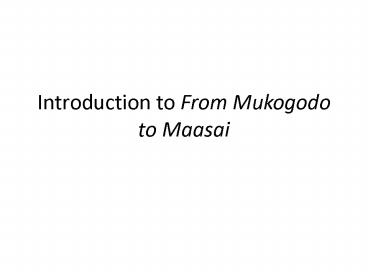Introduction to From Mukogodo to Maasai PowerPoint PPT Presentation
1 / 12
Title: Introduction to From Mukogodo to Maasai
1
Introduction to From Mukogodo to Maasai
2
Some Basic Facts about Kenya
- Independence in 1963 from Britain
- About twice the size of Nevada
- 37 million people
- Major exports tea, horticultural products
(flowers shipped to Europe), coffee - Democracy although last presidential and
parliamentary election (2007) marred by fraud and
riots - Provides shelter to almost a million refugees
from Somalia and Uganda
3
The Laikipia Plateau
4
Lee Cronk
- Anthropology Department, Rutgers University (NB)
- Lived among the Mukogodo, 1986-87, 1992, 1993
- His interest human behavioral ecology
5
Oil Consumption per person, 2006
6
What did it mean for the Mukogodo to be hunters
and gatherers?
7
The Original Affluent Society
8
Some anthropological terms
- Exogamy marrying outside your group
- Endogamy marrying inside your group
- Lineage exogamy marrying outside your lineage
- Patrilocal answers the question of where the
married couple live they live with the husbands
family or where the husband grew up after marriage
9
Aidan Southalls Definition of Tribe
- A whole society
- with a high degree of self-sufficiency
- at a near subsistence level
- based on a relatively simple technology
- without writing or literature,
- politically autonomous
- and with its own distinctive language, culture,
and sense of identity. - Added a sense of distinct identity---contrast
themselves to other groups
10
The Role of European Colonialism in Creating
Ethnicity in Africa
- Europeans grouped people together they spoke
similar or different languages but didnt think
of themselves as a single tribe - In Kenya, each ethnic group was given land for
reserves. - Europeans created chiefs for each ethnic group to
control them through indirect rule - This allowed elders to have more control in
determining tradition to control the younger
men and women. - European missionaries and African Christians
involved in writing down of local languages - Migrant men were more prone to tradition to
control women in the rural areas---through
hometown associations
11
Hutu Refugees from Burundis Violence, 1960s
- Two groups of Hutus from Burundi
- One group went to UN refugee camp and had a
strong sense of Hutu ethnic identity - Another went to live in a Tanzanian town on the
border and tried to assimilate as Tanzanians
- Purity and Exile,
- by Liisa Malkki (1995)
12
Current views on African ethnicity
- It was not that people were an undifferentiated
mass, but that they were differentiated in many
subtle and complex ways for different purposes
(Southall, p. 43) - Most Africans moved in and out of multiple
identities, defining themselves at one moment as
subject to this chief, at another moment as part
of this cult, at another moment as part of this
clan, and at yet another moment as an initiate in
that professional guild (Ranger, p. 603).

